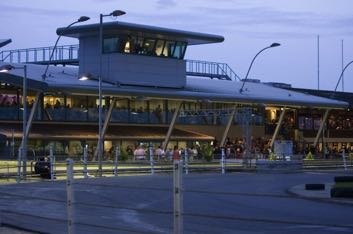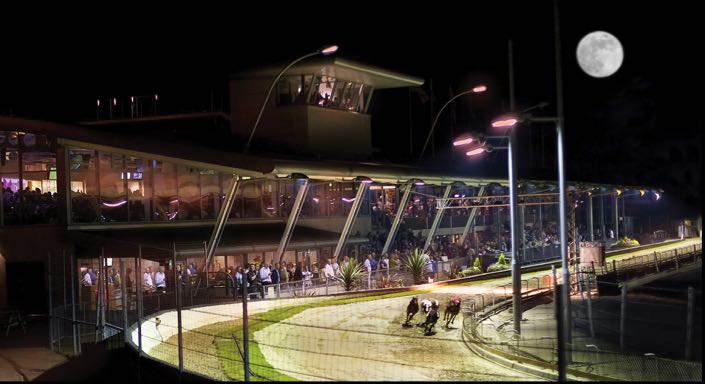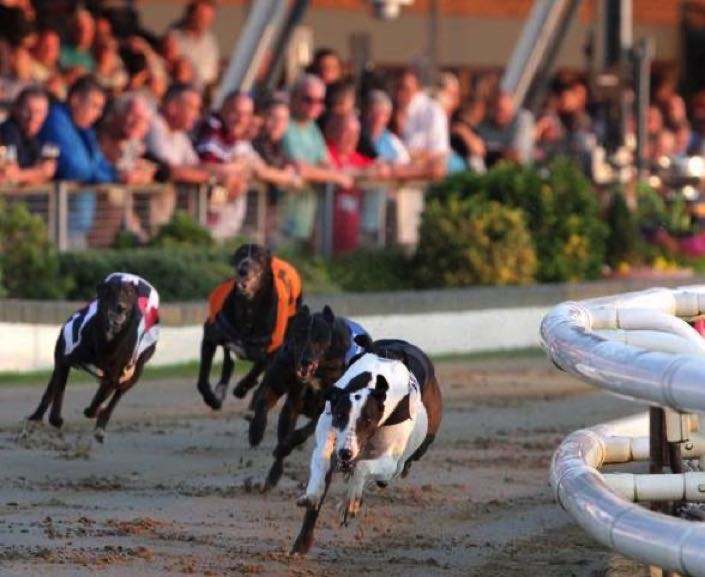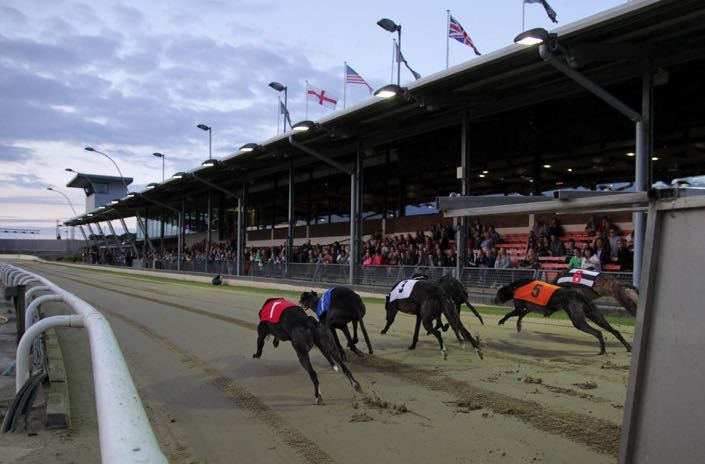- Address: Yarmouth Rd, Caister-on-Sea, Great Yarmouth NR30 5TE
- Telephone: 01493 720343
- Website: yarmouthstadium.co.uk/greyhoundracing

There is no dog track in the United Kingdom that is located further to the east of the country than Yarmouth Stadium. It is fair to say, therefore, that there is something of a target audience on offer to the venue when it comes to ensnaring people that wish to watch dog racing. With room for more than 5,800 spectators and parking onsite for about 1,000 cars, you’re unlikely to miss out on a space if you head to the stadium to watch some greyhound racing. It takes place on Monday, Wednesday and Saturday evenings.
Having first opened its doors in 1940, Yarmouth Stadium is located in the Borough of Great Yarmouth in Norfolk. It has been re-designed a number of times since it first opened, so that it now offers a state-of-the-art restaurant as well as fast food facilities for those that enjoy a more relaxed experience. It has hosted a few sports other than greyhound racing over the years, including speedway and stock car racing, the main sport has always involved dogs running around a track and trying to cross the finish line the quickest.
The Track & Facilities

Depending on the experience you’d like to have at Yarmouth Stadium, there are options open to you. The Raceview Restaurant boasts a modern design and has enough seating for 240 people, so booking a table there promises to be a really good time for all. In terms of the more relaxed atmosphere that many might wish to experience, there are fast food facilities as well as a few bars around the venue. If you would like to go even more up-market, one of the executive suites well might tick your box in that sense.
The track at the venue has a circumference of 382 metres, with the run to the first bend being 85 metres. With an Outside Swaffham hare in place, the races promise to be fast and furious as well as all sorts of entertaining. At the time of writing, the following distances are run at Yarmouth:
- 277 Metres
- 462 Metres
- 659 Metres
- 843 Metres
- 1,041 Metres
Major Races & Events

Given the remote nature of Yarmouth Stadium it is perhaps no surprise that the venue plays home to a few big events. Some of them are only big in the local sense, whilst others are well-known around the country. The likes of the Pepsi Sprint, the Derby Purse and the Fosters Cup have all called Yarmouth Stadium home at one point or another. Similarly, the Yarmouth Homefinders Veterans is a much-loved race on account of the older dogs running in it.
East Anglian Derby
Inaugurated in 1947, which was when Yarmouth Stadium was an independent track, the East Anglian Derby is run over 462 metres and in 2021 the winner took home £15,000. It was one of independent greyhound racing’s biggest events, but when the stadium switched to become a National Greyhound Racing Club venue, the race switched to taking place under rules. That was in 1975, with the prize money paid to winners ensuring that it is still a big race for licensed greyhounds. No trainer has won the event more times than Charlie Lister, whose name has been on the trophy 12 times.
In the News
If we’re all being honest with ourselves, it would be right to admit that when something appears in the news it isn’t always a good thing. It is a relief, therefore, that searches about Yarmouth Stadium don’t being up much of anything at all. There are articles about the biggest greyhound races to take place in the United Kingdom, as well as the fact that heading to the venue is one of the things to do in Great Yarmouth. Other than that, the only other news story featuring the dog track is one about the retired greyhounds looking for new homes.
About Yarmouth Greyhound Stadium

In 1928, two professional gamblers called Len Franklin & Ernie Wedon paid a visit to pre-war London and the newly built Clapton Stadium. It gave them the bug for greyhound racing, with Franklin in particular becoming a regular visitor to the likes of White City Stadium and Harringay Stadium. Having invested some stocks and shares, they decided to invest in a new business, purchasing a field to the west side of Yarmouth Road in Yarmouth. The field contained an unlicensed ‘flapping’ track, which had first opened for business on the 25th of March 1932, also hosting grass speedway events.
There were no structures at the track, which was on the opposite side of the road to a horse racing course. Soon they leased the field next door, which would allow for better access, and asked for planning permission for a new stadium. Initially this was turned down, but when they made an appeal to the ministry the decision was overturned. Construction began in 1939, with the new venue opening for business in the spring of the following year. The stadium would have opened on the 11th of May 1940, had Germany not invaded the Netherlands and Belgium.
Yarmouth Stadium’s Post-War History
When the German invasion took place, a decision was taken to evacuate Yarmouth. This meant that the afternoon meeting was still able to go ahead but it wasn’t in front of a crowd. Indeed, weekly meetings continued until many of the stadium’s staff were called up to serve in the Second World War. At that point, the stadium was closed down for racing and taken over by the fire service. In the wake of the war’s conclusion, the pair formed a partnership with Clifford Yaxley and together they formed the Norfolk Greyhound Racing Company.
The new-look company allowed them to take advantage of the boom in the industry that took place after the war’s conclusion, opening its doors to the public on the seventh of December 1946. Racing took place over 500 yards, whilst a restaurant in the Main Stand gave punters somewhere they could enjoy a bite to eat. Franklin was originally a steward and judge, with Wedon serving as Racing Manager, but when he sold his shares in order to buy Ipswich Stadium, Franklin took over the Racing Manager role for the venue.
Though speedway racing had taken place at the stadium since 1932, it began in earnest at the venue in 1948, continuing through until 1961. As a sign of the sort of job-sharing that was necessary for the group behind the venue, Ernie Wedon took on the role of Manager of the speedway team. Known as the Yarmouth Bloaters, the speedway team raced through this near-decade and a half period of time, enjoying limited success after starting life in the National League Division Three. Eventually, the team closed thanks to financial issues.
Though the East Anglian Derby was inaugurated at the stadium, it was an independent race on account of the fact that the track didn’t have an affiliation with the National Greyhound Racing Club until 1975. Before that the field where the original flapping track stood was sold, later becoming part of North Denes Airport. When Yaxley died suddenly, the Franklin family took over sole control of the stadium, sharing roles between members of the family. Racing took place on various days and times, running over 300, 500, 710 and 910 yards.
Becoming Licensed & Modernising
The Raceview Grandstand Restaurant opened in 1969, offering catering for up to 3,000 people, which was necessary after a stock car racing team had been formed there three years prior. In 1966, the team was known as the Bloaters, but it later became the Greyhounds. It was the first in what would be a number of steps towards the modernisation of the stadium. In 1975, Yarmouth joined the NGRC, with Dick Keable, by then the Racing Manager, celebrating 40 years at the track a decade later. History was made in 1987 when Yarmouth became the first permit track in the United Kingdom to register a totalisator turnover of £1 million.
In addition to the greyhound racing that was taking place at the stadium, the venue also hosted a market on Sundays and stock car racing three times a week. It was also a place where people could go to take part in some gambling activities aside from betting on the greyhounds, given that there was an arcade and occasional bingo nights. Stephen Franklin had taken over from Len as the Racing Manager, with his wife Pamela and children, Justin and Simon, also joining the business over the years.
Yarmouth Stadium in the Modern Era
when Nigel Long became the Racing Manager, Simon Franklin moved to the position of General Manager. Eventually, Simon Franklin and his brother Justin took over other roles at the venue, bringing in Nigel Bray to be the General Manager. One of the duties that the brothers had to concern themselves with was the construction of the new Main Stand, which was built in 2006 and cost £2.5 million. It was named the Len Franklin building, featuring a 250-seat state-of-the-art restaurant and three executive suites.
The TV Trophy was hosted by the track in 2007 and 2013, whilst the latter year also featured the Trainers Championship. When Walthamstow Stadium closed, Mark Wallis and John Mullins arrived at Yarmouth, having initially moved to Harlow Stadium. In 2012, improvements to the track were made at a cost of £190,000, which was also the year that Mark Wallis brought the ultimate prize to the track when Blonde Snapper won the English Greyhound Derby. In 2018, a deal with Arena Racing Company was signed, seeing racing take place every Monday and Thursday.
Track Records
Here’s a look at the records that have been set at the track over the years. Some of these distances aren’t run at Yarmouth anymore, whilst others might well have disappeared by the time that you read the site. We will try to keep it updated, but do bear in mind that these things change rather rapidly:
| Distance | Record Time | Date Set |
|---|---|---|
| 277 Metres | 16.02 Seconds | 21st June 2018 |
| 462 Metres | 27.17 Seconds* | 11th September 2010 |
| 462 Metres | 27.17 Seconds** | 10th September 2018 |
| 659 Metres | 40.07 Seconds*** | 18th May 2019 |
| 843 Metres | 52.86 Seconds**** | 26th August 2013 |
| 1,041 Metres | 68.81 Seconds | 8th December 1990 |
*Set during the semi-final of the East Anglican Derby
**Set during the Second Round of the East Anglican Derby
***Set during the final of the George Ing St Leger
****Set during the Heats of the TV Trophy